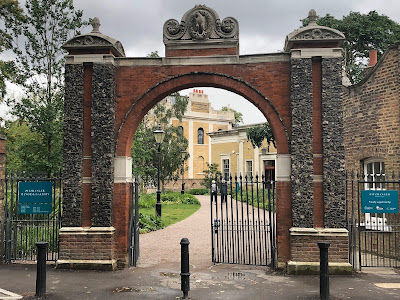Pitzhanger Manor
We are in Ealing to meet our friends Chris and Philippa who have taken us to see the recently restored Pitzhanger Manor and the newly upgraded art Gallery. Pitzhanger was the short-lived home of the architect Sir John Soane, who was architect and surveyor to the Bank of England for 45 years from 1788 to 1833. Soane set out to build a largely new country house, retaining only the left wing of the existing house. This had been added by George Dance, to whom Soane had been apprenticed. The design of the main part of the house is based on a Roman triumphal arch and is obviously much more elaborate and dramatic than Dance's wing. The caryatids, atop the four columns, are based on those in the sanctuary of Pandrosus in Athens.
You enter through this rather attractive archway.
We decided to start with the Gallery which had a wonderful exhibition of work by Anish Kapoor.
The exhibits are described as sculptures and consist of exceptionally clever and intriguing mirrors. For example, this one, in a corner, consists of two roundels. The right hand one is lacquered and placed so that the left hand one (which is a mirror) reflects its colours. However, the view alters according to where you are standing and then you notice that the left hand one in fact presents an upside down image.
We recently saw something similar, but simpler, by Kapoor: the Sky Mirror in Nottingham.
On the opposite wall a pair of linked spheres with open ends produced all sorts of complex reflections, again inverted.
Further mirrors reflected the beautiful roof lights. Some in the other room were more complex and produced an uncomfortable reaction in my brain (not Kapoor's fault).
We now headed across through the lovely columned passageway which leads to the house.
This meant that we arrived in the basement, but we headed up to the Dining Room which is in the left wing of the house, i.e. the wing added by George Dance. It is a large high room whose highlight is the fantastic and beautifully restored ceiling
The Breakfast Room is smaller and more domestic, but also has a lovely ceiling, this time with an almost Japanese feeling
The dramatic Small Drawing Room is a wonderful space, which like most of the house is sparsely furnished.
The nearby room, a sort of inner hall (I confess I can't remember its name), has a ceiling which is almost art deco.
We headed upstairs looking up the richly coloured stairwell ...
... to reach the main bedroom with its exquisite hand-painted wall paper.
That completed our tour of this wonderful building. It is rather sad that Soane spent four years (1800-1804) designing and constructing it and lived there for only six years before selling it and reverting to living in his London town house in Lincoln's Inn Fields, now Sir John Soane's Museum.
Pitzhanger was in private hands after 1810 but by 1900 it had been bought by Ealing Council and was used, with various changes and additions, from then until 1985 as a public library. It opened as a heritage attraction in 1987, showing contemporary art exhibitions from 1996. A major conservation project to restore the Manor to Soane’s original designs, and upgrade the contemporary Gallery began in 2015. It was led by Ealing Council in collaboration with Pitzhanger Manor & Gallery Trust. Well done to them!
Conditions: mild but showery.
Rating: five stars. An absolute delight.












































 ..
..











